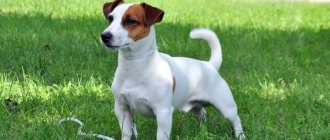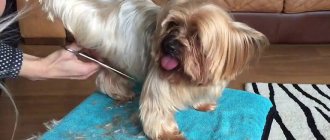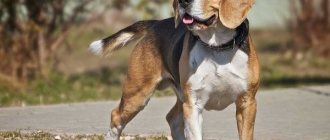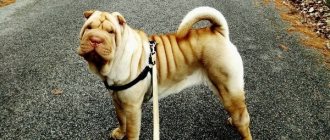To raise an intelligent and obedient dog that follows all the owner’s commands, training is needed. Many cities have special training courses conducted by professional dog handlers. But since this service costs money and, as a rule, is more often in demand among breeders of elite dog breeds preparing for various competitions and exhibitions, many owners train animals at home, resorting to simple and understandable recommendations from specialists.
In the article we will talk about the rules and methods of training dogs of large, small and medium breeds, at what age and how often you need to conduct training with a puppy, whether it is possible to train an adult dog, the main mistakes made by owners during training, training tips from experts.
Why train a dog
Training goals are set depending on the breed of the pet. The main ones are:
- Formation of an adequate response to surrounding stimuli. This could be transport, aggression from other pets, etc.
- Submission and obedience.
- Formation of the skill to make decisions independently when necessary to protect yourself and your owner.
Dog training should be done in a positive mood
General rules for self-training
Before training begins, the puppy must be shown what place he occupies in the family. The pet must know that the boss in the house is the owner and his commands must be followed.
Important! Accustoming to follow commands should not be accompanied by the use of violence. The puppy should feel love and care from its owner.
In order for self-training to produce results, you must follow the basic rules of dog training:
- Do not intimidate the animal.
- When requiring the execution of a command, use a minimum number of words.
- Monitor your pet's behavior.
- Always achieve the command.
- If the puppy is sick, do not teach the lesson.
- Always reward your pet for doing it correctly.
"Bite" to explain something
Until you became its owner, the dog was commanded by the mother. To deal with a disobedient child, the animal world has its own way: the mother bites the puppy in the neck or simply rolls it onto its back.
A person can also use these same methods, but to imitate a bite, you need to tense your fingers and simply hit the neck with the tips, but only from above, where the skin is rougher.
If the behavior has not changed, then throw the naughty person on his back. It is possible that the pet will not understand the first time, but by the third time he will definitely realize that he is to blame.
At what age can you train a puppy at home?
It is better to start training your pet in the fourth month of its life. But before that, simple skills need to be taught. For example, the puppy must know where in the apartment his place to rest and eat is. Also, before starting classes, the owner needs to thoroughly study the question of how to properly train a dog.
How to train a puppy correctly at home
When starting training, you should take into account the breed, character and temperament of the dog. For some pets, it is enough to give a command once and he will carry it out, while for others, on the contrary, it is necessary to repeat it several times.
The shepherd dog is the best dog to train, because serving its owner is in its blood. Labrador retrievers and poodles are also considered easy to train. It is more difficult with small breeds such as Yorkies or Spitz.
Note! The command base for each breed is different. For example, training small dogs does not have to include the "voice" command.
To me
You'll need an assistant here. You need someone to hold your puppy or on a leash while you walk a short distance away from him.
Stop, pat your hand on your thigh and say, “Come to me.” At this moment, the dog should be released so that it runs towards you. If he doesn’t run, squat down, start calling and show him the treat in your hands. When the puppy approaches, give him a treat and pet him.
If the dog ignores your command several times, pause and do something else, put it on a leash or leave the stick. Otherwise, the animal will decide that it is okay to disobey you.
Basic dog training methods
How to wash your dog correctly at home
Several methods are used during the training:
- Mechanical. This method involves physical contact with the dog, that is, pulling the leash, working with the animal’s body using your hands. Physical contact does not imply the use of physical force, and anger is not the best companion.
- Food. This method works as a reward for correctly completing a command.
- Game. The owner's task is completed in a playful way. The purpose of the method is to make learning an exciting process, to reinforce the rules for executing commands through the game. This could be a game during which you need to catch something, but it could be any other game aimed at a certain moment.
- Imitative. Puppies, especially when in a pack, observe their relatives, remembering their line of behavior and adopting it themselves. A striking example of the imitative method is training herding dogs to work, when the dog observes the work of an older comrade from childhood.
- Complex and contrasting. This method forms the basis of training and consists of a combination of different methods of strengthening reflexes and practicing skills.
The owner must always ensure that the task is completed
Rewarding good behavior
Every correct action or reaction must be rewarded. And do not wait for this specific moment, but reward the dog immediately: within a few seconds after the praiseworthy behavior. If the dog has committed an offense and followed the wrong command, there is no need to punish the pet or use physical force. It will be enough if you do not give the animal a treat, toy or other reward.
Your commands for which your dog can be rewarded should be simple and clear. For example, “sit”, “lie down”, “fu”, etc. So that the animal understands why exactly it is being praised. And also, if several family members will train the dog, the reward system should be identical and consistent. For performing the same commands, you need to reward your friend equally. If the gift consists of some kind of delicacy or sweetness, the main thing is not to overfeed. Keep treats to a minimum.
Features of training a puppy
The general course of puppy training must be selected based on the breed and purpose of the pet. It is necessary to conduct classes with a puppy for no more than 5-7 minutes at a time, because he needs to be allowed to rest.
In order for him to remember the technique of performing the required commands, classes must be regular. In the first months of life, you cannot skip training sessions. Puppies are quite impressionable and a mastered skill may be lost in the presence of new objects.
Note! Before starting a new exercise, you need to repeat the reinforced material. In addition, the learned commands must be repeated regularly during training.
Features of training different breeds
Dog training should be done taking into account that each breed has its own unique characteristics. That is why the approach to classes should be individual. Fighting breed puppies require maximum attention from childhood. This breed needs to be trained without using aggression or physical force.
Fighting individuals are in most cases aggressive in nature. If the owner feels that he cannot cope on his own, it is better to seek help from a specialist. A professional trainer will be able to find an approach to any pet and will even tell you how to train a mongrel dog at home.
Hunting dogs, such as huskies, are considered excellent companions and require active training. If a setter puppy appears in the house, the owner will need to prepare for regular, many-hour walks over rough terrain, where training should take place. First of all, such a breed must be taught the “Come to me” command, since any action of a foreign animal can provoke a hunting reflex in the pet.
Service breeds are designed to help people. As a rule, they are excellent guards, since this function is in their blood. Most often, a German or Caucasian shepherd is chosen for official purposes. Representatives of these breeds can even be police dogs. Their main feature is an acute need for human attention. In addition, shepherd dogs have special endurance and are ready to wait for hours for their owner.
Note! Mutts also lend themselves well to training.
Answer
The puppy has the roots of a fighting breed, in the described case a Staff, which can be reflected in a mixture with Labrador genes in a not very pleasant way. As practice shows, the nature of the Labrador is friendly. The dog is characterized by the following manifestations:
- kindness;
- equilibrium;
- responsiveness;
- mind;
- obedience;
- tenderness;
- agility;
- weasel;
- affection for the owners.
A cross with another breed, not even a fighting one, causes serious changes in the puppy’s behavior. You should be vigilant; selected deviations from the classic Labrador character are unacceptable when communicating between a dog and children!
Where to train your dog
For training, you need to choose a place that will meet a number of requirements. Namely:
- Extraneous, distracting factors should be completely absent. All the attention of the four-legged friend should be focused on the owner.
- There should be no other animals on the territory. Otherwise, during training the dog will be distracted by them.
- Lack of other people. During classes, only the owner and his dog should be on the site.
Important! It is best to start training at home and only after your pet gets used to doing it, move on to an outdoor area.
For the process to be productive, you must first earn the puppy's trust.
Commands for service dogs (“take”, “face”, “guard”, etc.)
There are situations when you need to train a service or guard dog. Here you will have to face a number of difficulties, since commands for them are considered the most difficult to master. It is better to train an animal under the guidance of an experienced instructor or even entrust the entire process to a dog handler. Improper training can result in negative consequences for the dog’s owner, those around him and other animals.
Trying to provoke aggression in a pet on your own is a huge mistake on the part of its owner. To train a dog with the commands “Take”, “Face” and “Guard”, 3 conditions are required: a closed area that excludes the presence of people in it, a protective suit and an experienced dog trainer.
Homeschooling
A familiar home is the best place to start the training process. It is best to choose a time when all household members are absent and the owner is alone with the dog. After mastering the usual commands, you can move on to training in the presence of other family members. This will help the dog get used to the presence of strangers when performing commands.
When all the commands have been studied, you can proceed to perform them on the street, but at the same time look for a place where there are no people.
Commands for a general training course
The commands that form the basis of the general course are the following:
- "To me". This command is learned simultaneously with the process of getting used to the nickname.
- “Fu” is the most important command, which, if successfully trained to perform it, will allow the pet to regulate its behavior.
- “Next” is necessary for the dog to walk on a leash next to the owner.
- “Sit”, “Lie down”, “Stand”, “Place” are the most important backbone of the commands with which the owner can control the behavior of his pet.
- “Give” is an effective method for stopping a dog from picking up foreign objects.
- “Fetch” - this exercise, as a rule, is liked by dogs, because usually the owner uses it during the game, forcing him to fetch a thrown object.
- “Face” - training is permissible only after the dog learns to follow all other orders of the owner. This command is, as a rule, the protection and protection of the owner.
Important! There is also the “Give me a paw” command, but it is not the main purpose of training. Each order should shape obedience from your four-legged friend.
Working breeds require special attention
Why punishment doesn't help
Each individual has its own character and temperament. With good motivation, any command will be carried out with joy. In addition, when a four-legged friend is raised without the use of physical force, he is more confident in his abilities. If you use harshness towards him, the owner risks getting an embittered or, on the contrary, a frightened and nervous adult animal, which, if the opportunity arises, will try to escape.
Important! To make your classes productive, you should watch a video lesson from a professional with instructions on training dogs.
Stand
It is better to learn this command when the dog learns to lie down when ordered. The lying position will be the starting position. The pet must be wearing a collar and on a leash. Lift your dog up by the leash until he stands on his paws. Voice the command and give a treat when the animal takes a stance. Treat him with a treat when the dog is standing upright, not trying to sit down on his butt.
Graphics: Dmitry POLUKHIN
Dog owner experience
Every dog owner makes mistakes when training them, but the main thing is to notice them in time and ask for help if necessary. Thus, experienced pet owners argue that the best way to teach a dog to follow commands is to earn his trust. With established mutual understanding, training will give the necessary results in a short time.
Important! Every mistake a dog makes is a mistake of its owner.
The dog should not be allowed to become overtired during tasks.
Advice from a specialist
Before training a dog, a novice owner would do well to listen to the opinions of professionals who will make the training effective:
- Before the lesson, you need to put your pet on a collar and leash; for convenience, you can lay out a blanket.
- One command can be repeated no more than 2 times.
- The sequence of commands must be in any form.
- The training time should be no more than 1.5 hours.
- It is necessary to maintain an interval between commands, because the dog must rest.
- For a correctly performed exercise, your pet should be rewarded with affection or a treat, for example, you can choose a truffle that has a pleasant smell.
- Many owners buy dogs to participate in events. An exhibition, for example, is a place where not only the exterior is assessed, but also command training.
A well-structured training process will bring pleasure to both the owner and the dog. You just need to be patient, study carefully the question of how to train a dog, and the result will not take long to arrive.
Auxiliary items
The key to good training is the correct choice of equipment. Here is the minimum set of auxiliary items that every dog breeder who trains his pet should have:
- training bag, feeding bag, bag for treats - this element of equipment is called differently, but the essence is the same - it contains a treat;
- regular and strict (metal) collars;
- short (1-1.5 m) and long (10-12 m) leashes;
- muzzle,
- the grip – also called a “rope” – plays the role of a conditional opponent, towards whom the dog’s teeth are redirected;
- noose, or ringovka - recommended for training with adult animals as part of a physical approach to training; it is better to purchase models with a lock, as they allow you to attach the noose to the desired area of the neck;
- a dumbbell is a surrogate substitute for hunted game, which the dog must fetch on the command “Fetch”, and then give to the trainer on the command “Give”; without a command, the dog should not react to a thrown dumbbell and pick it up from the ground.
A strict collar is used to train dogs that are not sensitive enough to normal painful stimuli. It is also recommended to purchase several toys to train your dog. The best options are an Arabian ball, a puller and a regular rope.











